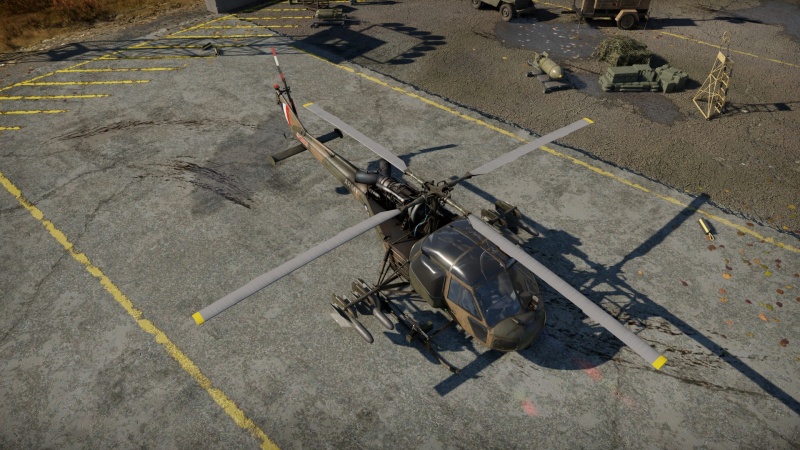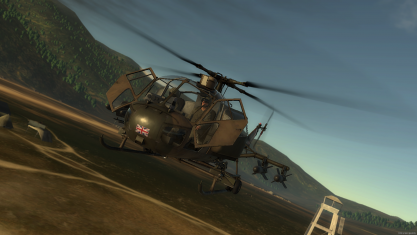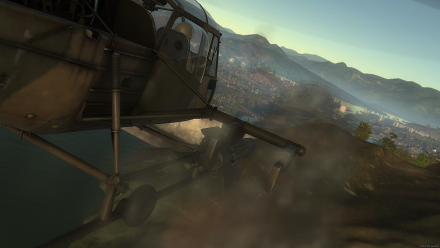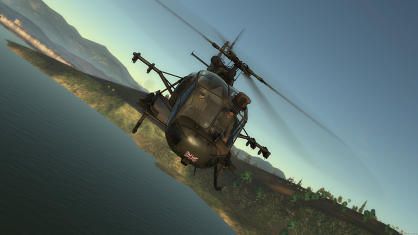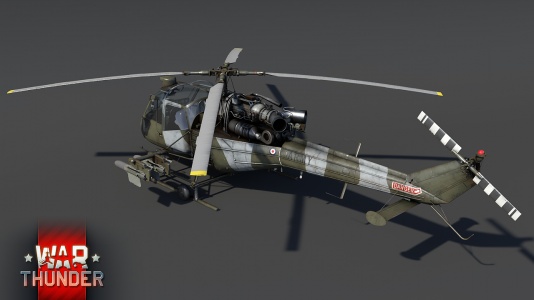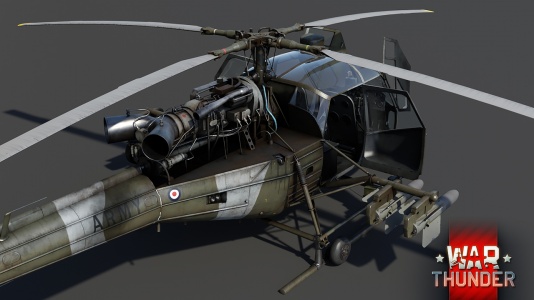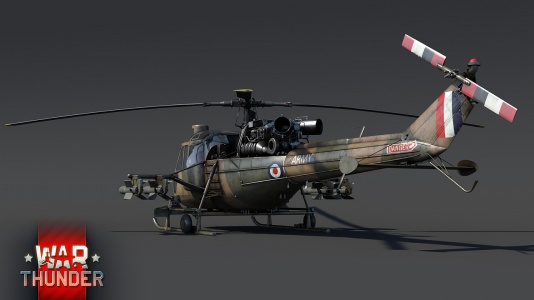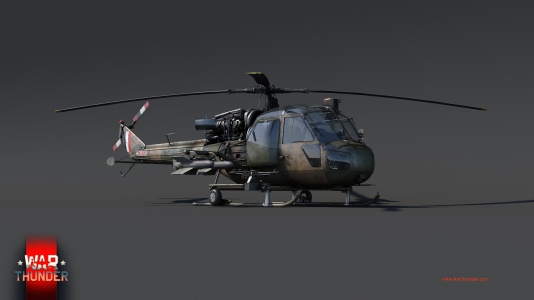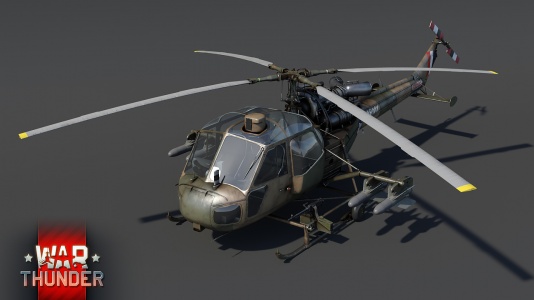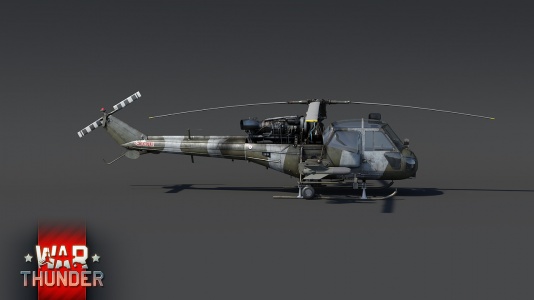Scout AH.Mk.1
| This page is about the British helicopter Scout AH.Mk.1. For other version, see Wasp HAS.Mk.1. |
Contents
Description
The Scout AH.Mk.1 is a rank V British utility helicopter with a battle rating of 8.7 (AB/SB) and 8.3 (RB). It was introduced in Update 1.91 "Night Vision". It serves as an opening helicopter for British pilots that will familiarise them with the game's helicopter mechanics.
As a matter of fact, this is not a rookie friendly vehicle due to several vulnerabilities such as a lack of armour, countermeasures and insufficient weaponry. It will require practice and good tactics to get in tune with it and efficiently provide good close air support without being blown out of the air by enemy air defence.
On the other hand, the Scout AH.Mk.1shares the same qualities as the later British helicopters; it is light, agile and fast.
General info
Flight performance
The flight performance of the Scout will prove to be rather satisfactory even when stock. It feels light, fast, and agile making it competent evading the barrage of things that will rain at you, including tank shells. It's speed and acceleration are sufficient to allow good positioning when the match starts, setting the collective to 80%, and keeping the pitch at +2.0°/-4.0° will usually be enough to reach top speed without gaining too much altitude or over-revving the propeller. Using the collective at 100% will increase thrust (useful when altitude is needed) but will reduce the horizontal speed drastically, making the helicopter prone to stalling during manoeuvres.
When manoeuvring to a different course keep in mind to not lose speed, the proper way to do this is to bank the helicopter towards the desired location before beginning the turn. This allows pilots to maintain their speed, indicated in the speed vector arrow at the centre of your heads up display (HUD).
The Scout only has one payload, so there is no negative performance impact. Using hover mode and locking the target from the gunner's sight considerably improves the chance of a ATGM impact but it's feasible to also hit tanks when on the move, thanks to the Scout's great agility and stability.
| Characteristics | Max Speed (km/h at 1,000 m) |
Max altitude (metres) | |
|---|---|---|---|
| AB | RB | ||
| Stock | 194 | 182 | 5400 |
| Upgraded | 232 | 213 | |
Survivability and Armour
No Armour
The Scout does not have any protective armour plates or bullet-proof glass, due to the sacrifices this would require in performance. The pilot should keep this in mind when flying. Rushing into the middle of the battlefield will end with disastrous results as the crew and vital components are only protected by the thin fuselage walls.
The pilot, gunner, engine, transmission, main rotor, and tail rotors are all exposed to fire from missiles, rockets, cannons, and even small-calibre machine guns. However, it is sometimes possible to survive multiple hits due to the spacious layout of the vehicle's components. The low velocity of small-calibre rounds is sometimes inadequate to penetrate the Scout's fuselage panels.
The same cannot be stated from 20 mm cannons and beyond that will shred the helicopter into a million pieces.
Survivability Improvement
The Flak jacket and Helicopter frame modules should be researched to increase the crew survivability against airburst shells that are extremely dangerous to your helicopter and crew. Pilots will be quick to notice the improvement in their helicopter's durability. A higher crew vitality (Pilot/Gunner) also improves survival.
Modifications and Economy
Thanks to great speed and agility, the modules of main concern relate to protection and survivability, such as the NVD or Flak jacket. The "Arcade Assault" game mode can allow rookie pilots to research the main modifications needed to improve the Scout for optimal performance in Mixed Battles.
Armaments
Offensive armament
The Scout AH.Mk.1 is armed with:
- 2 x 7.62 mm L8A1 machine guns, skid-mounted (250 rpg = 500 total)
The L8 MGs are rather inaccurate when not ungraded. British pilots should not rely on this to attack any ground target as they mostly serve to defend against pestilent air targets or helicopters on attack runs. A gun convergence of 600m is enough to fire effectively without getting too close to the enemy.
Suspended armament
The Scout AH.Mk.1 can be outfitted with the following ordnance:
- 4 x AGM-22 missiles
The AGM-22 missiles are usually good and enough to end with an armoured treat. Their SACLOS (Semi-Automatic Command to Line Of Sight) guidance requires the gunner to hold the reticule over the target until impact. It is recommended to aim for the sides of armoured vehicles, as some tanks are able to survive and frontal ATGM impact. Keep in mind the maximum range of 3 km and always anticipate a target's movement.
Usage in battles
As the Scout is such a weak target, the pilots must be aware of their surroundings and fight from the enemy's blind spots or flank, because a destroyed helicopter only assists the enemy's victory. Analyse and choose your side to engage in battle and preserve your helicopter.
Pilots should avoid high altitude combat with this helicopter for several reasons:
- Increased vulnerability to SPAA and SAMs
- Increased visibility to enemy pilots
- Decrease in flight performance
- Lack of cover
Mixed battles
The best flight approach is low as possible to the ground. The Scout can pass trees, houses, and mountains remaining almost undetected. Try to stay out of the enemy's half of the map, as their base AAA will likely detect you, and you are closer to newly spawned vehicles.
Instead. the Scout should support the allied offensive from a low, hidden spot launching the ATGMs to strategically eliminate enemies causing problems to the allied team.
In a winning match, opt for SPAA hunting as they mostly will focus on protecting themselves from allied tanks or jets. If losing, pilots could look for a window of opportunity and quickly cap a distant point to assist the allied team in turning the tide of the battle.
- In empty or flat maps, the Scout is of minimal effectiveness due to the lack of cover. Instead, an aircraft fitted with ATGMs or rockets would be more suitable.
Pros and cons
Pros:
- Light and nimble - useful for evading enemy fire
- Small and stealthy - one of the smallest helicopters, makes hiding easy
- Perfect for nap-of-the-earth (NoE) flying
- Decently fast even when stock
- Powerful AGM-22 missiles. Able to destroy most of the tank's frontal armour at the battle rating.
- Quite a strong frame, will often be heavily damaged but remain operable
Cons:
- Limited weaponry (only 4 AGMs) and defensive 2x 7.62 mm machine guns
- Exposed engine won't take a lot of damage before failing.
- No countermeasures
- Very vulnerable pilots and critical components due to lack of armour
- Lengthy grind due to poor survivability
- Other helicopters are very dangerous
History
Development on the Westland Scout began in the late 1950s, at the Saunders-Roe company. Saunders-Roe developed their Saro P.531 light utility helicopter, which itself was based on the design of a previous piston-engine helicopter. The Saro P.531 already had several prototypes built and tested by the time the company was acquisitioned by Westland, who in turn, decided to continue development of the P.531.
As a result, in the early 1960s, the Westland Scout was created. The Scout conducted its maiden flight in August 1960 and was well-received with both the British Army and Royal Navy during testing. Following the favourable reception, the helicopter was subsequently ordered into production for the Army as the Scout AH Mk.1.
As work on the Scout steadily progressed, Westland continued developing a naval-capable version of the vehicle in parallel. The 'Sea Scout', as it was initially designated, only featured several minor design differences from the base model, such as a wheeled undercarriage and foldable blades and tail section, along with some other differences. After being reviewed by the Royal Navy, the 'Wasp' as it eventually became known, entered service with the Royal Navy in 1963, alongside the Army's Scout.
Both versions of the helicopter took part in combat operations during their service, most notably in Borneo, the Falklands and Northern Ireland. In the end, around 280 machines of both types were built, including export models.
- From Devblog
Media
- Skins
- Images
- Videos
See also
External links
| Westland Aircraft Limited | |
|---|---|
| Aircraft | |
| Fighters | Whirlwind Mk I · Whirlwind P.9 |
| Turboprop | Wyvern S4 |
| Helicopters* | |
| Attack | AH Mk.1 Apache** |
| Utility | Wessex HU Mk.5 · Scout AH.Mk.1 · Wasp HAS.Mk.1 · Lynx AH.Mk.1 · G-LYNX |
| *After World War II, Westland Aircraft focused on building helicopters and changed its name to Westland Helicopters. | |
| **Licensed AH-64D | |
| See Also | Boeing Aircraft |
| Britain helicopters | |
|---|---|
| Attack | AH Mk.1 Apache · Rooivalk Mk1F CSH · Superhind |
| Utility | Wessex HU Mk.5 · Scout AH.Mk.1 · Wasp HAS.Mk.1 · Lynx AH.Mk.1 · G-LYNX |



